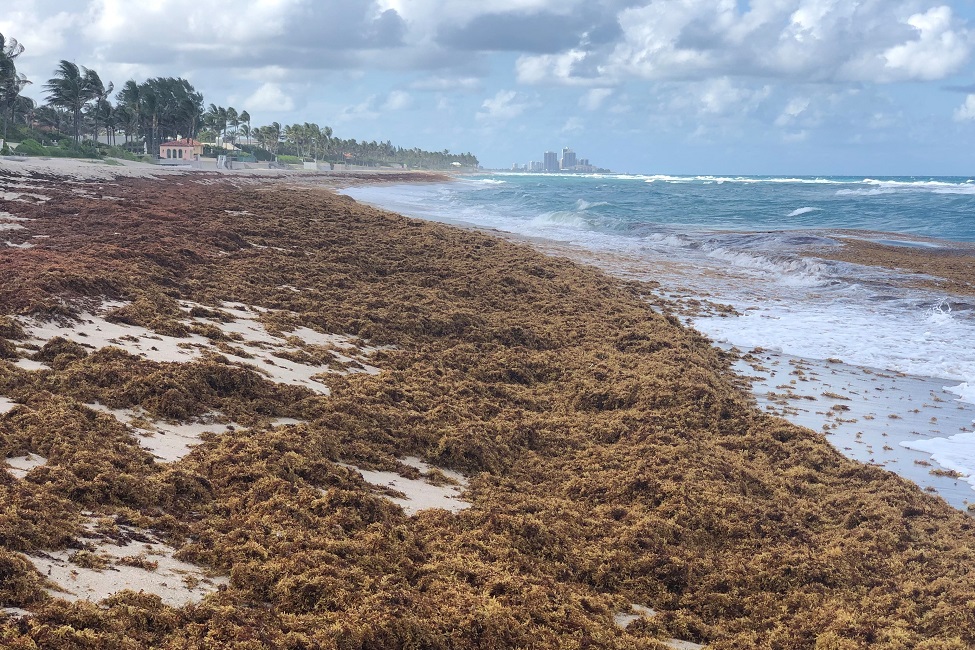'Pathogen' Storm: Vibrio Bacteria, Sargassum and Plastic Marine Debris

Some cultivation-based data show beached Sargassum appear to harbor high amounts of Vibrio bacteria. (Photo credit: Brian Lapointe, FAU Harbor Branch)
A new study uncovers how the interplay between Sargassum spp., plastic marine debris and Vibrio bacteria creates the perfect “pathogen” storm that has implications for both marine life and public health. Vibrio bacteria are found in waters around the world and are the dominant cause of death in humans from the marine environment. For example, Vibrio vulnificus, one of more than 100 species of Vibrio, sometimes referred to as flesh-eating bacteria, can cause life-threatening foodborne illnesses from seafood consumption as well as disease and death from open wound infections.
Since 2011, Sargassum, free-living populations of brown macroalga, have been rapidly expanding in the Sargasso Sea and other parts of the open ocean such as the Great Atlantic Sargassum Belt, including frequent and unprecedented seaweed accumulation events on beaches. Plastic marine debris, first found in surface waters of the Sargasso Sea, has become a worldwide concern, and is known to persist decades longer than natural substrates in the marine environment.
Currently, little is known about the ecological relationship of vibrios with Sargassum. Moreover, genomic and metagenomic evidence has been lacking as to whether vibrios colonizing plastic marine debris and Sargassum could potentially infect humans. As summer kicks into high gear and efforts are underway to find innovative solutions to repurpose Sargassum, could these substrates pose a triple threat to public health?
Researchers from Florida Atlantic University and collaborators fully sequenced the genomes of 16 Vibrio cultivars isolated from eel larvae, plastic marine debris, Sargassum, and seawater samples collected from the Caribbean and Sargasso seas of the North Atlantic Ocean. What they discovered is Vibrio pathogens have the unique ability to “stick” to microplastics and that these microbes might just be adapting to plastic.
“Plastic is a new element that’s been introduced into marine environments and has only been around for about 50 years,” said Tracy Mincer, Ph.D., corresponding lead author and an assistant professor of biology at FAU’s Harbor Branch Oceanographic Institute and Harriet L. Wilkes Honors College. “Our lab work showed that these Vibrio are extremely aggressive and can seek out and stick to plastic within minutes. We also found that there are attachment factors that microbes use to stick to plastics, and it is the same kind of mechanism that pathogens use.”
The study, published in the journal Water Research , illustrates that open ocean vibrios represent an up to now undescribed group of microbes, some representing potential new species, possessing a blend of pathogenic and low nutrient acquisition genes, reflecting their pelagic habitat and the substrates and hosts they colonize. Utilizing metagenome-assembled genome (MAG), this study represents the first Vibrio spp. genome assembled from plastic debris.
The study highlighted vertebrate pathogen genes closely related to cholera and non-cholera bacterial strains. Phenotype testing of cultivars confirmed rapid biofilm formation, hemolytic and lipophospholytic activities, consistent with pathogenic potential.
Researchers also discovered that zonula occludens toxin or “zot” genes, first described in Vibrio cholerae, which is a secreted toxin that increases intestinal permeability, were some of the most highly retained and selected genes in the vibrios they found. These vibrios appear to be getting in through the gut, getting stuck in the intestines and infecting that way.
“Another interesting thing we discovered is a set of genes called ‘zot’ genes, which causes leaky gut syndrome,” said Mincer. “For instance, if a fish eats a piece of plastic and gets infected by this Vibrio, which then results in a leaky gut and diarrhea, it’s going to release waste nutrients such nitrogen and phosphate that could stimulate Sargassum growth and other surrounding organisms.”
Findings show some Vibrio spp. in this environment have an ‘omnivorous’ lifestyle targeting both plant and animal hosts in combination with an ability to persist in oligotrophic conditions. With increased human-Sargassum-plastic marine debris interactions, associated microbial flora of these substrates could harbor potent opportunistic pathogens. Importantly, some cultivation-based data show beached Sargassum appear to harbor high amounts of Vibrio bacteria.
“I don’t think at this point, anyone has really considered these microbes and their capability to cause infections,” said Mincer. “We really want to make the public aware of these associated risks. In particular, caution should be exercised regarding the harvest and processing of Sargassum biomass until the risks are explored more thoroughly.”
Study co-authors represent the NIOZ Royal Netherlands Institute for Sea Research, the Japan Agency for Marine-Earth Science and Technology, the Ludwig Maximilian University of Munich, Germany, Emory University, the University of Amsterdam and the Marine Biological Laboratory.
This research was supported by the National Science Foundation (NSF) (grant OCE-1155671 awarded to Mincer), FAU World Class Faculty and Scholar Program (awarded to Mincer), NSF (grant OCE-1155571 awarded to Linda A. Amaral-Zettler, Ph.D., corresponding author, NIOZ), NSF (grant OCE-1155379 awarded to Erik R. Zettler, Ph.D., co-author, NIOZ), NSF TUES grant (DUE-1043468 awarded to Linda Zettler and Erik Zettler).
-FAU-
Latest Research
- FAU CARD Releases Free Water Safety Guide for Children with AutismDrowning is the top cause of unintentional death for children aged 1 to 4 in Florida, and autism increases the risk. FAU's CARD is offering a free guide to help protect children with autism from drowning.
- Fewer Parasites in Indian River Lagoon Signal Big Ecosystem ProblemsFAU Harbor Branch researchers used parasite data to assess the ecological health of Florida's Indian River Lagoon, which has suffered from pollution and algal blooms, damaging habitats like seagrass beds.
- BEPI Poll: Hispanic Economic Outlook Drops Amid Tariffs, Rising PricesAs households face increasing prices for goods and talk of new tariffs, Hispanic optimism in the economy waned in the first quarter of 2025, according to a poll from BEPI at Florida Atlantic University.
- FAU Joins First Global Effort to Map Microplastics in Ocean SystemsAn FAU researcher joins an international team of scientists who have moved beyond "scratching the ocean's surface," marking a turning point in understanding microplastics' path through critical ocean systems.
- FAU CA-AI Lands $2.1M to Form New U.S. Air Force Center of ExcellenceTo address critical U.S. Air Force communications needs, FAU engineering's CA-AI has received a $2.1 million grant from the U.S. Department of Defense Air Force Research Laboratory.
- Nursing 2025: No Relief as Burnout, Stress and Staffing Woes PersistA new national survey from Cross Country and FAU of 2,600 nurses and nursing students paints a sobering picture of a profession at a breaking point and an urgent call to action.






